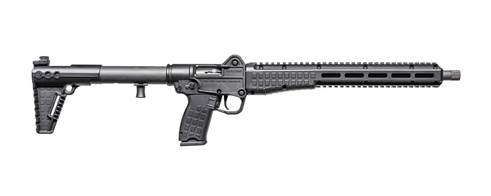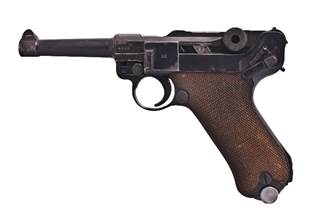Most gun nuts have a favorite firearms designer – Eugene Stoner, Mikhail Kalashnikov, and John Browning are usually the popular ones. John Garand’s M1 rifle is iconic. Gaston’s Glock is a household name. Suppressor fans may name Hiram Maxim. Bill Ruger would be an obvious mention thanks to the success of Sturm, Ruger & Co. There may be some who prefer the classics such as Paul Mauser, Samuel Colt, Oliver Winchester, or the duo of Smith & Wesson.
Somewhere, no doubt, someone is screaming “Sergei Mosin!” at their computer screen.
But let’s cut against the grain and shine the light on the more underrated and often forgotten firearms designers.
Dieudonné Saive
May 23, 1888 – Oct 12, 1970

Belgian designer Dieudonné Saive is criminally underrated. If you have heard of him, you are likely aware that Saive was at one time a personal assistant to the legendary John Browning, but Saive’s contributions extend far beyond that role.
In 1921, the French military issued a contract for a new sidearm that was to be compact, hold at least 10 rounds, must be effective to at least 50 meters, be robust and reliable, be easy to assemble and disassemble, and must contain a magazine disconnect safety, an external hammer, and a safety device. FN’s chief weapons designer John Browning, was uninterested. It wasn’t until Saive successfully designed a double stack magazine mated to a modified Browning designed FN Model 1903 did Browning accept the project.

On Nov 26, 1926 John Browning passed away. With Colt focused on the 1911, Val Browning offered his father’s designs to Saive. By 1931 the Hi-Power featured a 13rd magazine and a barrel bushing integral to the slide. By 1934, eight years after the passing of John Browning, Saive completed the Hi-Power.
Double stack magazines were not new, but they weren’t particularly successful either. The greater capacity magazines of the C96 Broomhandle Mauser, the P08 Artillery Luger and the early 20th century Savage pistols were still very much unusual and these pistols found very limited success. Saive’s magazine design was revolutionary and is arguably one of the most greatest influences of modern handguns.

By 1930, Saive was FN’s chief weapons designer and he completed in the Hi-Power in 1934. During World War 2, he fled Nazi-occupied Belgium and continued to contribute to the war effort, designing two new rifles, the SLEM-1 and SLEM-2 (Self Loading Enfield Model).
Post-war, Saive completed the FN49. While the FN49 was a durable, reliable, and high quality rifle it simply could not compete successfully with the new battle rifles.

Saive then co-developed the a legendary rifle known as the Fusil Automatique Léger (Light Automatic Rifle) or more simply the FAL. The FN FAL became known as the “Right Arms of the Free World” and one of the most successful battle rifles ever devised.

The FAL was and still remains a fantastic rifle by any standard. It was adopted by over 90 countries, made under license in 15 countries, and continues to be made to this day.
Saive retired in 1954 and passed away in 1970, but his designs continue to live on and still influence firearms to this day.
Hugo Schmeisser
Sept 24, 1884 – Sept 12, 1953

Hugo Schmeisser is likely the most recognizable name on this list and for good reason. Schmeisser’s is best known for his submachine gun designs, but Schmeisser’s real legacy is that he is the inventor of the modern assault rifle.
While employed at Bergmann Waffenfabrik in 1918, Schmeisser developed the MP18 for the German Army in World War 1. The MP18 was only produced for two years, but it made a very memorable mark. Schmeisser followed the MP18 up with the MP28 cementing his legacy on submachine guns.

Though he wasn’t involved in the development of the new MP40, his influence led to the MP40 to be referred to as a “Schmeisser”. It really goes to show just how influential Schmeisser was for the design of SMG’s.

Schmeisser’s most impactful work was the Sturmgewehr 44 or StG44 – the world’s first true assault rifle. It fired an intermediate 7.92x33mm cartridge, it was select-fire, compact and controllable. The StG44 was compact and controllable like a submachine gun and yet it fired a rifle cartridge with greater range and power than the submachine gun.
After WWII, Schmeisser was taken by the Soviets and sent to factory number 74, now known as Izhmash. How Schmeisser spent his time in the Soviet Union and what, if any part, he played in the creation of the AK47 is disputed. Here is what we do know:
- The Soviet Union captured one of the most important firearms designers of all time and put him to work in a planet well known for manufacturing Soviet weapons including the Kalashnikov series of rifles.
- The Red Army had captured STG44 rifles and had produced several themselves.
- In the 1940’s the Soviets had created the 7.62x39mm and the M43 cartridge, and were looking for a new rifle for the M43, but none were selected.
- In 1945, the same year Schmeisser was captured, the Soviet Union opened a competition for developing a new rifle. Designers were encouraged to “borrow” from other designs and the judges often made “suggestions” for the designers guns.
- The AK47, a brand new rifle, was completed approximately two years after Schmeisser was captured and placed in a weapons factory, and looked eerily similar to the StG44.
Jim Sullivan
June 27, 1933 – Sept 22, 2024

Eugene Stoner gets all the credit for the AR-15, but Jim Sullivan deserves equal praise.
In 1954, Eugene Stoner came to work as chief engineer for ArmaLite, a division of Fairchild Engine & Airplane Corporation.
By 1955, Stoner completed a little project he called the ArmaLite AR10. The new rifle was submitted to the US Army’s Aberdeen Proving Ground for evaluation, but the Army eventually selected what was to be the M14.

Sullivan joined the team at Armalite in 1957, reporting directly to Stoner.
Sullivan led the team in scaling down Stoner’s AR-10 design into a light, small caliber rifle that today we call the AR-15. He also contributed to the development the Stoner 63 which saw limited success with the US military in Vietnam.

In 1965 Sullivan went to work for Ruger and designed two guns; the M77 and the Mini 14. The M77 came out of Bill Ruger’s desire to make a rifle comparable in quality to the pre-1964 Winchester Model 70 and the Mini 14 was, as the name suggest, Ruger’s idea to scale down the M14 into a 5.56mm rifle.
Under the guidance of Sullivan, Chartered Industries of Singapore developed the Ultimax 100 light machine gun. The Ultimax utilizes the “constant recoil” operating system, making it one of the most controllable light machine guns on the market.

Sullivan continued innovating, co-developing the Surefire Optimized Bolt Carrier Group (OBC). Surefire claims the OBC will increase reliability and reduce recoil.
George Kellgren
May 23, 1943

Swedish-born George Kellgren is one of the most creative and divisive firearms designers of the modern era. George Kellgren is the man behind Kel-Tec, and has a long track record of the most out-of-the-box innovations.
One of Kellgren’s earliest designs was with Intratec, an American subsidiary of the Swedish Interdynamic AB when he developed the Intratec TEC-9.

In 1990 Kellgren founded Grendel, Inc and then founded Kel-Tec in 1991.
He helped pioneer ultra-light concealed-carry pistols like the P3AT, the lightest production 380 Auto pistol in the world. The P3AT and the P-11 helped ignite a boom of pocket pistols in the 2000s.

Kellgren went on to design a slew of quirky and unique firearms:
- SUB-2000: A folding pistol-caliber carbine that accepts Glock mags.
- RFB: A forward ejecting 308 bullpup rifle that accepts FAL mags.
- PF9: The flattest and lightest 9mm pistol ever produced.
- PMR-30: A 30rd 22WMR pistol.
- KSG: The 15rd bullpup shotgun of John Wick fame.
- RDB: A downward ejecting 5.56mm bullpup rifle.

More recently Kellgren dropped the PR57, perhaps the stranger handgun of the modern era. The PR57 is a 20rd 5.7mm pistol utilizing a rotary barrel system and fed by stripper clips.
Georg Luger
March 6, 1849 to December 12, 1923

You know the name, but Georg Luger doesn’t get the credit he deserves.
Over 100 years ago Georg Luger invented the 9x19mm Parabellum. Today it is a standard cartridge for NATO and many other non-NATO countries. It is the world’s most popular and widely used military handgun and submachine gun cartridge. The 9x19mm is by far the most popular handgun cartridge for self defense in the United States. The cartridge is utilized in the most popular handguns by a who’s who of handgun manufacturers including Sig Sauer, Glock, Smith & Wesson, Springfield Armory, Beretta, H&K, and FNH.
But Luger didn’t just design the 9mm Parabellum, he was also a prolific firearms designer.

Originally refining the Borchardt C-93, Luger streamlined the design and created the Luger P08 pistol. The Luger became legendary for its elegant design and natural pointability – it was a prized souvenir for allied troops during World War 2 and is still prized to this day by collectors.
Luger’s work created both a legendary pistol and the most, if not one of the most, enduring cartridges in firearm history.
Ronnie Barrett
May 13, 1954

Ronnie Barrett is really an obvious choice that seems to get overlooked.
Barrett had no experience, nor background in manufacturing or engineering. Barrett simply sketched out a design for a semi-automatic 50 BMG rifle and with the help of Bob Mitchell, they built a porotype in a garage in less than four months. That prototype was the Barrett M82.

Barrett continued to improve the design out of a small shop at his home. Sales were slow until the CIA took notice and began purchasing. In 1989 the Swedish Army became the first army to purchase a Barrett rifle. In 1990, the US military began purchasing the rifles.
Barrett later developed the updated M82A1, the M107, the M95, and thee M99.
Barrett even went on to develop a new lightweight hunting rifle series known as the Fieldcraft and their own AR-lines known as the REC7 and REC10.
In 2016 Barrett’s home state of Tennessee named the Barrett M82 the official rifle of the State of Tennessee.
Barrett is only one of seven firearms designers who’s firearms have been adopted by the US military in the last 100 years. Barrett is the only one of those seven to design his rifle, create his rifle, manufacture his rifle, build a brand around his rifle, mass produce his rifle, and sell his rifle. And he did it all without government funding or a corporate parent.


Leave a Reply